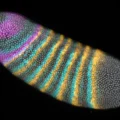The syncytial mammalian muscle fiber contains a heterogeneous population of (myo)nuclei. At the neuromuscular junction (NMJ), myonuclei have specialized positioning and gene expression. However, it remains unclear how myonuclei are recruited and what regulates myonuclear output at the NMJ. Here, we identify specific properties of myonuclei located near the Drosophila larval NMJ. These synaptic myonuclei have increased size in relation to their surrounding cytoplasmic domain (size scaling), increased DNA content (ploidy), and increased levels of transcription factor pMad, a readout for BMP signaling activity. Our genetic manipulations show that local BMP signaling affects muscle size, nuclear size, ploidy, and NMJ size and function. In support, RNA sequencing analysis reveals that pMad regulates genes involved in muscle growth, ploidy (i.e., E2f1), and neurotransmission. Our data suggest that muscle BMP signaling instructs synaptic myonuclear output that positively shapes the NMJ synapse. This study deepens our understanding of how myonuclear heterogeneity supports local signaling demands to fine tune cellular function and NMJ activity.








No Comments
Leave a comment Cancel